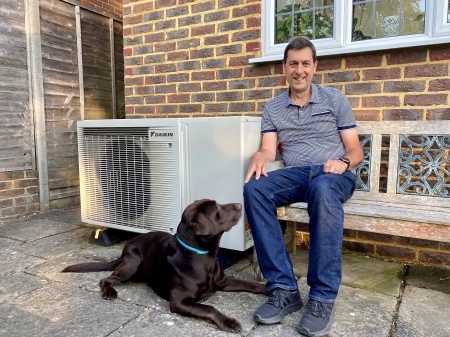
Cutting carbon and costs in the kitchen — Low energy, low cost meals
In the UK, we spend about £343 each on food every month, and according to USwitch, the cost of cooking all that food amounts to about 4% of your annual energy bill.
A few years ago, Cass Bailey, writer of the food and lifestyle blog ‘Diary of a Frugal Family’, gave us some tips on making low-carbon, cheap meals to help everyone reduce their carbon footprint at home.
With energy prices on everyone's mind, we thought we’d revisit some of her tricks and share what else you could do to save time, money and energy in the kitchen.
Here are some of her amazing tips on how you can do just that:
Energy-efficient cooking
Microwaves, slow cookers and air fryers
Using slow cookers, microwaves and air fryers when you can, are all great options for low-maintenance, low-cost, low-carbon cooking.
Microwaves: When it comes to cooking quickly and cheaply, microwaves are going to be your best friend. Cooking a potato in a conventional oven will use up to 10x as much energy as a microwave! This is because microwaves use less energy for every hour they're in use (fewer kilowatts per hour). There is no heat-up time, helping to make the cooking process quicker. You can cook a jacket potato in roughly 10 minutes in the microwave, but it would take almost an hour to bake in the oven.
Slow cookers: Despite needing to cook your food for longer, slow cookers operate at a much lower temperature and use less energy than a traditional oven, which makes them cheaper to run. In fact, they're so energy efficient that they can use less energy than a conventional light bulb! Plus, all you need to do is add the ingredients in the morning, and a few hours later, you have a hot meal ready to serve. Need some inspiration? Here are 10 cheap slow cooker recipes to get you started.
Air fryers: As with slow cookers, air fryers need to heat up a much smaller space than a traditional oven. Therefore, they require fewer kilowatts per hour to heat up to the required cooking temperature, cutting your energy usage.
Ovens - Shut that door!
Using an oven can't always be avoided but our oven loses heat incredibly quickly when the door is open. That means using more energy to get back up to the programmed temperature. Opening the door as little as possible will help save energy, and make sure you use the fan setting if you’ve got one.
On the topic of ovens, another trick is to turn your oven off ten minutes before the end of the cooking time – you won’t notice the difference, promise!
Batch is best
If you’re making something you know you’ll enjoy again, why not double the portions so there’s enough left over to freeze for another meal? Things like chilli, bolognese, stews, casseroles and sauces are versatile, easy to portion and store, and great for freezing. Less cooking time = less energy used.
When the time comes, just take your portion out of the freezer the night before so it thaws in the fridge overnight. Then pop it in the microwave or on the hob while you boil some pasta or bake a potato - et voila! You’ve got a tasty low-carbon meal minus the effort.
The secret to low-carbon, low-cost meals? It starts before cooking
1. Plan your meals and use what food you’ve got.
If you don’t already plan your meals for the week, it's the perfect time to start. Our top tip is to sit down on a Sunday night and make a quick list of what you’ve got in the fridge that needs to be used. You might be able to rustle up a few obvious dinners, but if you need some inspiration, you could try a recipe generator.
Tesco has created a handy website that lets you list the ingredients you’ve already got. It will suggest recipes once you’ve entered only a few items. Using a tool like this will save you money and energy by helping you use what you’ve already got, rather than letting food go to waste. You can get some great ideas for cheap recipes and seasonal meals.
2. Low-carbon foods
Food production and processing is a major contributing factor to our carbon footprints – in the UK, the average diet-related carbon footprint is around 5kg a day. But do you really know your food carbon footprint? The BBC created a handy food carbon emissions calculator so you can see the environmental impact on some of your favourites.
But what’s driving that number up, and what can you do to bring it down?
Load up on veggies
Food production accounts for almost a quarter of all greenhouse gases, and more than half of this comes from meat and animal products. The single biggest change we can make to reduce our food carbon footprint is to eat less meat – this alone could reduce your carbon footprint by two-thirds.
Ditch the dairy – It’s not just meat, though – butter, cheese and milk are also driving your footprint way up. A study by Science Focus found that a 200ml glass of dairy milk requires over ten times as much water and three times as much CO2 than a 200ml glass of soy milk.
Buy seasonally
Seasonal eating means eating foods at the time of year they’re naturally in harvest. The globalisation of food production means you can find almost anything in the supermarket all year round, so it’s not always obvious what’s in season at home and what’s been grown overseas and imported.
There are definitely benefits to seasonal eating, though. Strawberries in winter could cost twice as much as in summer, and they’ve probably travelled a long way, losing nutrients and freshness on the way, as well as racking up quite the carbon footprint.
Tips for seasonal eating:
- Make sure you know what’s in season and what’s not – this list of seasonal fruit and veg is a great start
- Browse your local greengrocer or farmer’s market – you’re more likely to find seasonal produce from small, local growers in independent shops or markets
- Shopping online? Check to see if your supermarket has a seasonal aisle
- Grow it yourself! You don’t even need a garden – herbs and things like lettuce and leafy greens can easily be grown on a windowsill or in a balcony planter
- Stock up and freeze your favourites. Love blueberries? Stock up in July when they come into season and keep them in the freezer
A low-cost, low-carbon meal to get you started:
Slow cooker vegan chilli
To get you started on your low-carbon culinary journey we wanted to share a tasty recipe that ticks all the boxes. It’s vegan, you can make it in a slow cooker, and the ingredients are all deliciously low carbon. The best bit? There are only 3 steps!
|
2 tsp. vegetable oil 1 large onion, finely chopped 1/2 -1tbsp hot chilli powder, to taste 1 tsp. ground cumin 1 tsp. smoked paprika 2 garlic cloves, crushed 1 tbsp. tomato purée 2 celery sticks, finely sliced 1 carrot, peeled and chopped 1 red pepper, finely sliced 1 large sweet potato, peeled and cut into 2cm pieces 400 g tin chopped tomatoes 400 g tin kidney beans, drained and rinsed 400 g tin black-eyed beans, drained and rinsed 400 ml vegan vegetable stock 25 g vegan dark chocolate Small handful of coriander leaves, roughly chopped (optional) |
Cooking instructions 1) Heat the vegetable oil in a large pan over medium heat. Add the chopped onion with a large pinch of salt and cook for 10 minutes, stirring regularly, until softened. Then stir in the spices, garlic and tomato purée, and cook for 1 minute before transferring to your slow cooker 2) Add the vegetables, tinned tomatoes, beans and stock to the slow cooker. Cook on high for 4 hours or until the sweet potato is cooked through (poke it with a fork to check) 3) Stir through the dark chocolate until it melts, and sprinkle with coriander (if you’re using it). Serve with rice and guacamole in a bowl or as a wrap |
If that recipe has inspired you, there are plenty more low-carbon recipes to try out.
More ways to live low carbon
We've all heard the saying 'waste not, want not'. Reducing waste, whether it's food or the energy you use for cooking, is a great way to save money and lower your carbon footprint. We hope we've given you some ideas on how to start thinking about your food-based emissions and ways you can live low carbon.
If you want to find out more about how to make your home truly low carbon, check out our energy efficiency home page.
Related articles

Get shifty and reduce your carbon footprint

